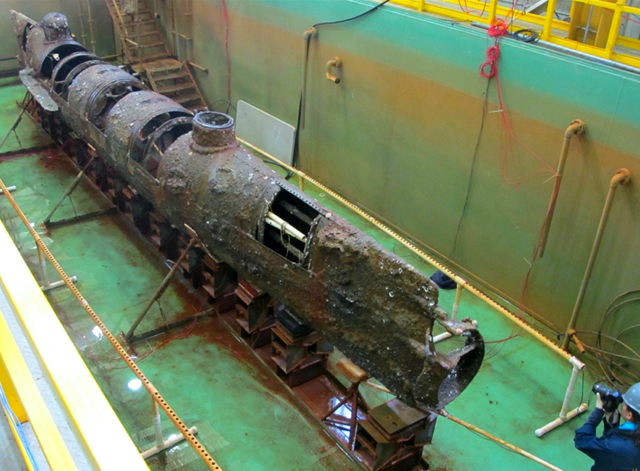C.S.S. Hunley Attacks
February 17,1864 an officer aboard the U.S.S. Housatonic spotted "something in the water" coming towards the ship. An explosion resounded as 135 pounds of  gunpowder tore through the hull of the Housatonic, near the magazine. Panic ensued as the ship rapidly sank stern first. While only
five sailors unable to abandon the ship died, the attack served to break the blockade around Charleston and strike fear into the Union fleet.
gunpowder tore through the hull of the Housatonic, near the magazine. Panic ensued as the ship rapidly sank stern first. While only
five sailors unable to abandon the ship died, the attack served to break the blockade around Charleston and strike fear into the Union fleet.
The C.S.S. Hunley, an experimental craft, had pulled off the daring mission. The submersible vessel rammed a torpedo into the side of the Housatonic. Previously it had been believed that the Hunley planted the bomb with a hook into the side of the enemy ship and detonated the charge with a line trailing from the submersible when the Hunley reached a safe distance. Lt. George E. Dixon and his crew of six perished during the operation when the vessel floundered in the harbor.
However, new evidence shows the mission of the C.S.S. Hunley to be far more dangerous than originally perceived. During test runs in the Charleston Harbor the trigger line from the torpedo to the Hunley became tangled in the vessel's propeller, exposing a large flaw in the design. Desperation to break the blockade pushed the Confederates to adopt a far more dangerous plan. Instead of detonating the torpedo at a distance it seems the Hunley attached the explosive to its prow, ramming it directly into the side of the Housatonic and detonating the explosive. This put the crew of the Hunley a mere 20 feet from the explosion rather than the originally thought 100 feet. To top it off previous tests with 65 pound torpedoes had failed to sink the desired ships, so the Hunley's Torpedo weighed in at 135 pounds. Even so, no evidence points to the Hunley's mission being one of suicide, although very hazardous. At least 33 men had died merely testing the vessel before its attack on the Housatonic.
The following are reports from Confederate officers recorded in the Official Record associated with the attack of the Hunley. General Beauregard was the commander of Confederate forces defending Savannah.
The first report indicates the Hunley may have surfaced and signalled after the attack, although it is possible the signal was sent prior to the attack in order for the crew to ascertain their bearings when surfacing.
HEADQUARTERS BATTERY MARSHALL,
Sullivan's Island, February 19, 1864.
LIEUTENANT: I have the honor to report that the torpedo-boat stationed at this post went out on the night of the 17th instant (Wednesday) and has not yet returned. The signals agreed upon to be given in case the boat wished a light to be exposed at this post as a guide for its return were observed and answered. An earlier report would have been made of this matter, but the officer of the day for yesterday was under the impression that the boat had returned, and so informed me. As soon as I became apprised of the fact I sent a telegram to Captain Nance, assistant adjutant-general, notifying him of it.
Very respectfully,
O. M. DANTZLER,
Lieutenant-Colonel.
Lieutenant JOHN A. WILSON,
Acting Assistant Adjutant-General.
[Indorsement.]
FEBRUARY 20, 1864.
As soon as its fate shall have been ascertained pay a proper tribute to the gallantry and patriotism of its crew and officers.
G. T. BEAUREGARD,
General, Commanding.
Report of Confederate General Beauregard to Confederate General Cooper:
General S. COOPER,
Adjt. and Insp. General Richmond, Va.
CHARLESTON, S. C., February 27, 1864.
Prisoners report that it was the U. S. ship of war Housatonic, twelve guns, which was sunk on night 17th instant, by the submarine torpedo-boat, Lieutenant Dixon, of Alabama, commanding. There is little hope of safety of that brave man and his associates, however, as they were not captured.
G. T. BEAUREGARD,
General, Commanding.
HEADQUARTERS, &C., March 10, 1864.
H. J. LEARY, Esq.,
Marietta, Ga.:
SIR: I am directed by the commanding general to inform you that it was the torpedo-boat H. L. Hunley that destroyed the Federal man-of-war Housatonic, and that Lieutenant Dixon commanded the expedition, but I regret to say that nothing since has been heard either of Lieutenant Dixon or the torpedo-boat. It is therefore feared that that gallant officer and his brave companions have perished.
Respectfully, your obedient servant,
H. W. FEILDEN,
Captain and Assistant Adjutant-General.
Long, E. B., and Barbara Long. The Civil War Day by Day; an Almanac, 1861-1865. Garden City, NY: Doubleday, 1971. Print.
Hicks, Brian. "Hunley Legend Altered by New Discovery." The Post and Courier. The Post and Courier, 28 Jan. 2013. Web. 18 Feb. 2013.
Photo courtisy of:
Gerardvanderleun. "This Just In from the Civil War: The Confederate Submarine
H.L.Hunley Has Risen Again @ AMERICAN DIGEST." This Just In from the Civil War: The Confederate Submarine H.L.Hunley Has Risen Again @ AMERICAN DIGEST. American Digest, 12 Jan. 2013. Web. 18 Feb. 2013.


